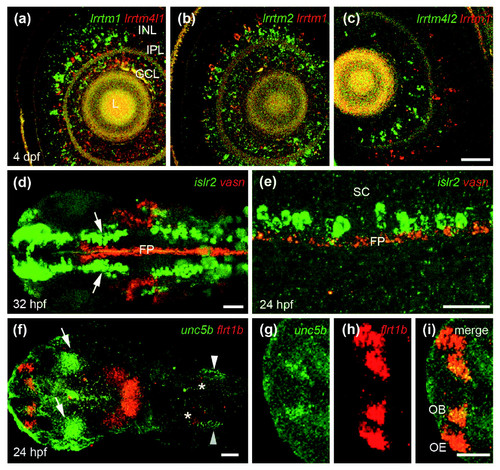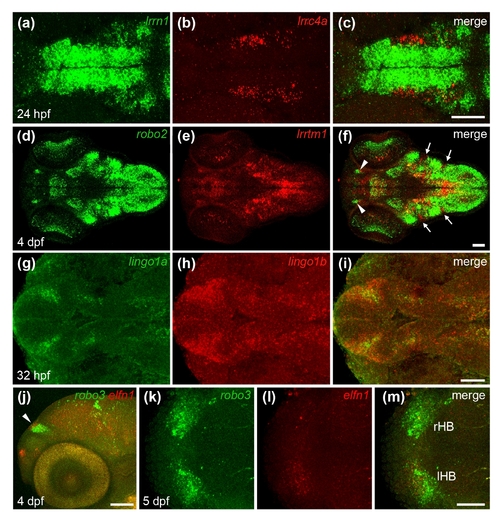- Title
-
A cell surface interaction network of neural leucine-rich repeat receptors
- Authors
- Söllner, C., and Wright, G.J.
- Source
- Full text @ Genome Biol.
|
Two-color wholemount in situ hybridization of interacting neuroreceptors. (a-c) Single optical sections showing largely non-overlapping expression of the Lrrtm genes within the inner nuclear and ganglion cell layers of 4 days post-fertilization zebrafish retinae. Note that the confluent yellow staining within the lens represents background auto-fluorescence in both channels. (d-e) Neuron-glia interactions. (d) Dorsal view of the head region of a 32 hour post-fertilization (hpf) zebrafish embryo: vasn (red) is expressed in the most ventral part of the spinal cord in the medial floor plate cells (FP). islr2 (green) is expressed in fore-, mid- and hindbrain neurons; note that the midbrain neurons are in direct contact with the floor plate (arrows). (e) Lateral view of the developing spinal cord of a 24 hpf zebrafish embryo showing discrete cells within the spinal cord (SC) that are directly adjacent but dorsal to the floor plate. (f-i) Dorsal views of a 24 hpf zebrafish embryo showing expression of unc5b (green) and its interacting partner flrt1b (red). (f) unc5b is expressed in the dorsal retina (arrows) and the ear (arrowheads), flrt1b in the dorsal regions of the lateral midbrain and mid-hindbrain boundary; expression is also detectable in the vestibulo-acoustic ganglion (asterisks). (g-i) Higher magnification of the forebrain showing that unc5b is also expressed in the medial part of the olfactory bulb (g) where it overlaps with the flrt1b staining (h) in the olfactory bulb (OB) and olfactory epithelium (OE) (i). Scale bars: 50 μm (a-c); 80 μm (d); 40 μm (e); and 50 μm (f-i). GCL = retinal ganglion cell layer; INL = inner nuclear layer; IPL = inner plexiform layer; L = lens; OB = olfactory bulb; OE = olfactory epithelium. |
|
(a-c) Dorsal view of the zebrafish midbrain at 24 hours post-fertilization showing the nlrr1 gene (a) is expressed throughout the neuroepithelium of the midbrain, whereas its receptor, ngl2 (b), is restricted to two lateral midbrain domains that directly abut the nlrr1 expression domain (c). (d-f) A single optical section through the brain of a 4 days post-fertilization (dpf) zebrafish larva showing that robo2 (d) and lrrtm1 (e) are expressed in restricted patterns within all brain regions. The merge (f), shows largely non-overlapping, adjacent expression, particularly in a forebrain nucleus (arrowheads) and the hindbrain (arrows). (g-i) Dorsal view of the forebrain and partial midbrain of a 32 hours post-fertilization zebrafish larva showing that lingo1a (g) and lingo1b (h) are expressed in partially overlapping domains in the telencephalon (i). (j) Lateral view of a 4 dpf zebrafish larva showing robo3 expression in green and elfn1 expression in red. Both genes are expressed in the habenula nucleus in the dorsal forebrain (arrowhead). (k-m) Dorsal view of the forebrain region of a 5 dpf zebrafish larva showing that robo3 is expressed symmetrically in both habenula nuclei (k), whereas elfn1 (l,m) is expressed asymmetrically with higher expression levels in the left nucleus (lHB). All images are two-color wholemount in situ hybridizations with anterior left; cartoons depicting the interacting receptor-ligand pairs are shown in the left panels. Scale bar: 50 μm (a-c,d-f,g-j,k-m); 93 μm (j). |


